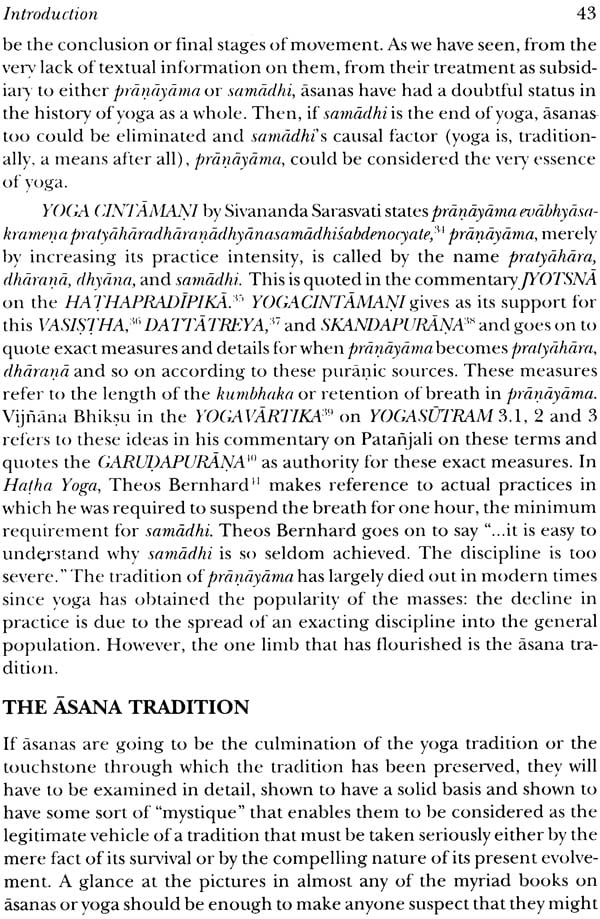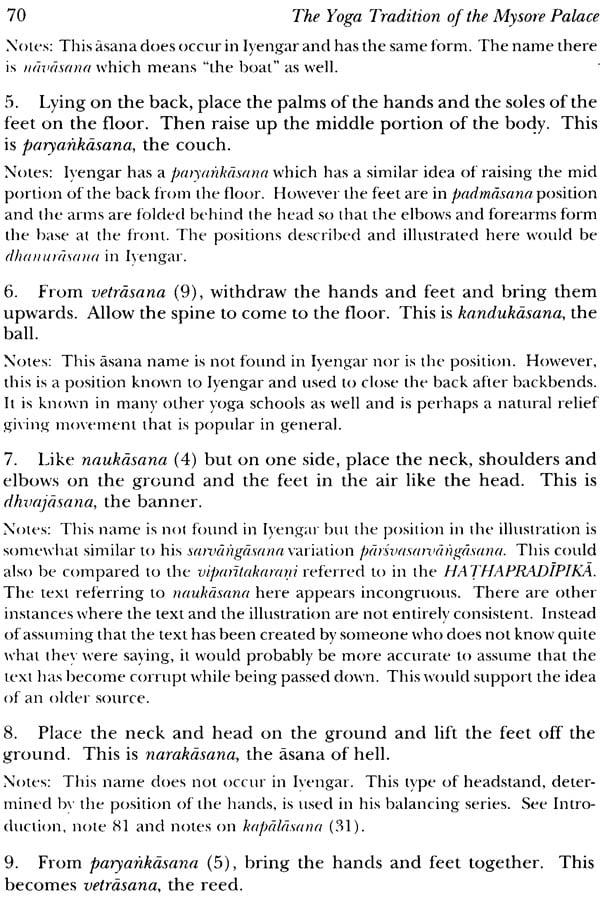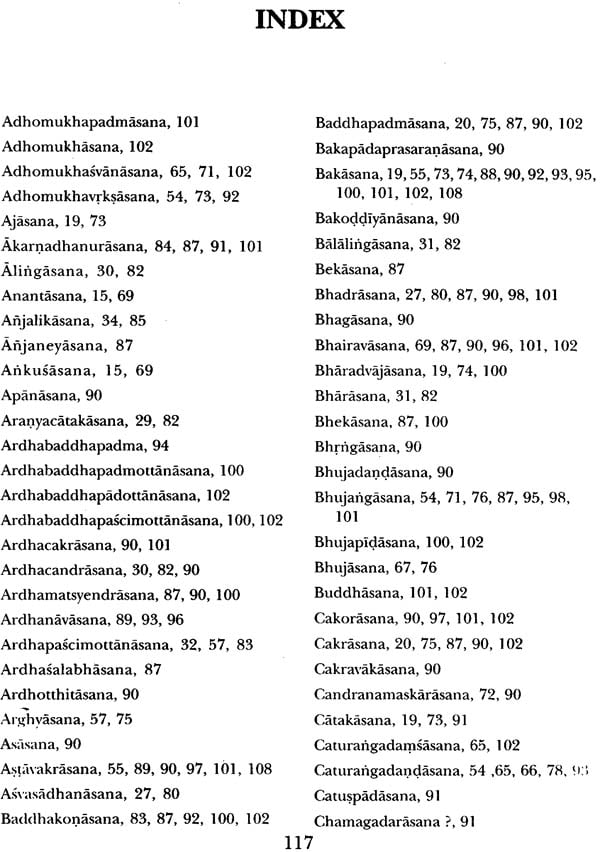
The Yoga Tradition Of The Mysore Palace
Book Specification
| Item Code: | IDE063 |
| Author: | N E SJOMAN |
| Publisher: | ABHINAV PUBLICATION |
| Language: | English |
| Edition: | 2022 |
| ISBN: | 8170173892 |
| Pages: | 128 (Color Illus: 122, B & W Illus: 4) |
| Cover: | Hardcover |
| Other Details | 10.3" X 7.7" |
| Weight | 620 gm |
Book Description
"The Yoga Tradition of the Mysore Palace" traces the developments in the yoga tradition that has led to the strongest yoga tradition practiced in the world today, from Krishna-macariar to Pattabhi Jois' Astanga yoga system and the Iyengar system. The spread of these yoga systems all over the modern world is unparalleled in the history of yoga; it partakes of the nature of a mass movement. The introduction traces the development farther back by looking into a history of asanas itself, garnering evidence from different periods in Indian history and relating this to the basic texts of yoga philosophy. The book requires us to view the history and development of yoga from an entirely new perspective. The introduction centres around a translation of the yoga section of the SRITATTVANIDHI, the oldest text available at present substantiating a developed asana practice. This text, written in 1880's, foreshadows our own period.
The author, Dr. N. Sjoman, is a Sanskritist trained in traditional Sanskrit schools as well as in Universities in North America, Europe and India eventually taking a Vidyavacaspati degree from Pune University. Initially, he learned yoga from B.K.S. Iyengar and continued as a student during an eighteen year sojourn in India. He has taught yoga with Sri Dattatreya all over the world. He received an Honorary Doctorate in Yoga from the Nippon Yoga Gakkei in 1982. He has published academic articles, articles on art and culture and a book with Sri Dattatreya entitled "An Introduction to South Indian Music". He is a visual artist, a painter, sculptor, and textile artist.
There is continuous record of involvement and patronage of yoga at the Mysore Palace for over 200 years. The oldest record found are in the SRITATTVANIDHI, the most complete documents in the History of Yoga Asanas found todate. This work was compiled by Mummadi Krishnaraja Wodeyar himself and is translated with the illustrations here.
The introduction traces other influences in the Yoga System. It documents the educational interests and efforts of Nalwadi Krishnaraja Woderyar in installing Krishnamacariar at the Palace and in the Yoga Sala, teaching Members of the Royal Family and the and the Public at large through the Royal Pathasala.
That Yoga System, a synthesis of many different schools of exercise, some almost defunct, has spread over the entire World through its primary preceptors Krisnamarcariar, B.K.S. Iyengar and Pattabhi jois.
It is gratifying to look back at the farsightedness of my ancestors and know that, through them, countless students of Yoga, all over the World, in every single country, have been able to share in the benefits and secrets of Yoga.
The response to the book has been gratifying and refreshing for the most part. It is a privilege to be able to bring out the second edition.
In this second edition, there are a number of minor errors or omis- sions that have been corrected. B.K.S. Iyengar has stated that he was never Pattabhi Jois' student. This has been incorporated in the text. There have been some minor additions to the bibliography that bring up to date recent material on the Yogasutram of Patanjali. My own study of the Yogasutram is now complete and brings to a conclusion my studies of the history of yoga as such. This has been hastened, actually made largely unnecessary, by the excellent comparison of Buddhist meditation prac- tices with the meditation practices in Patanjali's sutras published by S. Tandon. Occasions remain for studies to amplify sketchy parts and re- claim transfigured parts of this reconstituted yoga history.
The criticism that the Indian schoolmen make of western thinkers is that they are unaware of their presuppositions. The presuppositions, which here are actually the reasons why people do yoga-why very, differ- ent people in different times have done yoga, have been carefullyexem- plified in this book. Literature indicating animistic beliefs, a search for power, sympathetic magic appropriation, deliberate delusionary tactics, therapeutics and health, social groupings, a gradated spiritual discipline, a basic metaphysical understanding and so on have been presented as diverse points of view. This is an attempt to understand an underlying motivation for following the teachings of yoga and thus, to understand why yoga has survived. This appears to have passed unnoticed by most readers. This is not surprising as there has not even been any attempt at understanding the implications of the fact that the book brings into question the particular narrative history of yoga as it is known and drawn on by trying to trace an outline of the important developments in the practice tradition. It would seem to be a serious problem if our history, which presumably forms the basis for our action, is shown to be largely fabrication.
. Yoga as a spiritual discipline is discussed in the context of Indian metaphysical systems. Linkages have been made to the Yogasutram and I have gone on, as mentioned above, to write articles examining further the sutras of Patanjali. This examination has not been academic, but technical in terms of the philosophy, and speculative. This examination, interdisciplinary by nature, draws on and includes the work of practi- tioners of meditation ... the work of people who have practised yoga and meditation as a spiritual discipline.
Interestingly enough, in our own time, yoga has become a social phenomenon. This might be partly because the most recent innovative practitioners of yoga have been Vaishnavas who seem to be oriented more towards social organization-social systems, status, economics, however one wants to see it, than the Saivites who have had their heyday more than one hundred years ago and have formerly been on the fringes of social apparatus. Of course, the whole guru-sisya tradition is part of a social bonding complex and is particularly attractive at present to people who are alienated from family complexes; one of the most difficult as- pects of our perilous modernism. I have heard a yoga student say, "PattabhiJois is like a father to me". With such emotive social complexes one is invariably entangled in all the moralizing, status seeking and so on that goes with the territory. And the territory is social loyalty or group- ing, competition and economics.
In fact, most of the yoga people who have commented on the book have been interested in the particular status of their teacher or have wanted to elicit some gossipy titbit from me. I have been very careful to avoid this with full awareness that the world runs on gossip. I have been very careful to excise such elements from the work presented. These sorts of statements perhaps serve the "hagiographical imperative" quite efficiently. My interests, though, have been the particular and not the general. As I try to avoid generalities leaving my mouth, I have for the most part failed to live up to these interests. I have also avoided respond- ing when reproached with generalities. All the same, I have tried to be generous with my information and have let, as far as possible, the re- search speak for itself. Because of this, the reader can form his own con- clusions. Pattabhi Jois, when asked what he thought of this book, told one of his students that I had written it just to make money off of him.
The few academics that have commented have been mostly inter- ested in the preface where they are referred to and have told me repeat- edly that academics are 'Just like that" but they were never able to say such things themselves. In other words" they have co-opted my indepen- dence and made me one of them. Others, who I won't mention by name as they are not part of this story, have said that the book is "not quite academic". Others again have proclaimed my research "may be flawed". It is not possible to address these statements since no details are given, for example, as to the nature of the "flaws". Indeed, one might suspect that such statements are maliciously intended in that they question the credibility of what has been offered without offering specific critique, opportunity for dialogue, for rejoinder, correction or modification of views. The careful documentation of my statements, however, speaks for itself. This kind of critique is power tripping. And that has been impor- tant in our own scholastics, our history and the history of yoga.
Yoga spread into China primarily because of the promise of super- natural powers. The mythology of Superman is the American counter dream. And there is a dream battle going on, a battle of mythology and metaphysics. I tend to think of the American Superman dream as more adolescent. The Indian yogi figure is more practical in some senses- attractive to people who have already abandoned Superman and maybe even Santa Claus (economics?). But the Indian yogi figure, in spite of the Vaishnavite socialization, is an outlaw by nature, specifically, by the nature of his sadhana. The power dream although dubious at best, is a fantasy to work by, a rite of passage, but perhaps ultimately unsustain- able to a keen student of yoga. The serious pursuit of yoga is a touch- stone that allows us to generate our own individual understanding from a corporeal base. But dream worlds have the imprint tenacity of delu- sion based advertising. Yoga has been around a few more years than Superman; indeed, it is probably the mythological source complex of the latter and is, in a very individual or personal way, the archetypal mythical hero journey. The continued interest of the western world in yoga, in advertising and the ideas of purity, tradition, superiority, the ideas of privileged and powerful secret knowledges that one can acquire like TVs and cars all belong to that same complex and inform the guru- sisya complex as understood today. One can witness the success of the term "power yoga" that has so recently appeared and come into vogue.
B.K.S. Iyengar, in a remark he probably does not remember, said to me once, "Everything has come to me but nothing stays."
Patanjali has said that a word, once spoken, sets up a vibration that continues on into infinity. He also says that one single word, correctly spoken, is sufficient to achieve enlightenment. The vibration that is the primal desire to speak is the vibration that originated this universe. The realization of that primal vibration was a mystical experience. All this might point to the fact, among other things, that we ought to be careful what we say.
People have misinterpreted my dedication. The "whistle blowing yogis" are the Nathas according to Briggs. But he made a mistake, it was not a whistle they carried but a chillum. Why would yogis want a whistle?
The yoga tradition that evolved through the patronage and partici- pation of the Wodeyar royal family, rajas of the kingdom of My sore , has today supplanted or affected a majority of the yoga teaching tradi- tions primarily through the teachings of B.K.S. Iyengar and his students. This tradition is strongly preoccupied with the practice of asanas or yoga positions, appears to be distinct from the philosophical or textual tradi- tion, and does not appear to have any basis as a tradition as there is no textual support for the asanas taught and no lineage of teachers. A trans- lation of the "SRITATTVANIDHI" manuscript from the Mysore Palace from somewhere between 1811 and 1868 containing 121 illustrations of asanas presented here indicates some sort of textual basis. An attempt to trace the tradition historically indicates a much older tradition and gives us a glimpse into the actual evolvement of the teachings of yoga from the time of Patanjali. This enables us to examine our ideas of "tradition" and the treatments of tradition by the adherents of the textual tradition, the ancient practitioners of yoga and the modern students of yoga who claim ancient authority. The attempt to study the asana tradition by comparing names of asanas with older sources and other traditions reveals a com- mon fund and considers material that should give us a surprising and direct insight into dynamic living tradition-into the very essence of tradition that makes it a living tradition rather than a lineal historic tradition created and substantiated by academic tradition. Through the understanding gained in this process, it is possible to evaluate modern practices of yoga which have evolved towards therapy within a dynamic historical background. Through that, and the understanding gained from actual practices, it is possible to return to the oldest source, Patanjali, and re-interpret one of his sutras in what must be a more complete manner; it makes the sutra meaningful.
| Foreword by His Highness, Srikantadatta Narasimharaja Wadiyar | 3 |
| Preface to the Second Edition | 5 |
| Preface to the First Edition | 9 |
| Mysore Yoga Painting | 13 |
| Synopsis of Painting by Swami Sivapriyananda | 14 |
| Illustrations of the Asanas from the SRITATTVANIDHI | 15 |
| Introduction | 35 |
Patanjali
The Nature of Indian Tradition 36 The Yoga Tradition 36 Textual Survey of the Yoga Tradition 37 Modern Practices of Yoga 39 The Subject and Source of the Present Study 40 Development in the Philosophical Yoga Tradition from 41 The Asana Tradition 43 The Modern Asana Traditions 48 B.K.S. Iyengar's Asana Teaching 49 Pattabhi Jois's Asana Teaching 50 B.K.S. Iyengar's Reformation of the Jois/Krishnamacariar Series 50 Krishnamacariar's Yoga Teaching 50 Krishnaraja Wodeyar - Student and Patron of Yoga 52 The Mysore Palace Gymnastic Tradition 53 The Mysore Palace Wrestling Tradition 56 The Yoga Section of the SRITATTVANIDHI 57 Conclusions 59 | |
| Translation of the SRITATTVANIDHI Text | 69 |
| Appendix I - Alphabetical list of asanas from The Complete Illustrated Book of Yoga | 87 |
| Appendix II - Alphabetical list of asanas from First Steps to Higher Yoga | 90 |
| Appendix III - Alphabetical list of asanas from the Hathapradipika, Gherandasamhita, Sivasamhita and Goraksasamhita | 98 |
| Appendix IV - List of asanas in the order taught by Pattabhi Jois at his Astanga Yoga Research Institute in Mysore | 100 |
| Appendix V - Alphabetical list of asanas from Krishnamacariar's Yogamakaranda | 102 |
| Appendix VI - Yoga section of the Maisuru Maisiri | 103 |
| Appendix VII - Photographs from the Vyayamadipika | 106 |
| Appendix VIII - Photographs from Krishnamacariar's Yogamakaranda | 108 |
| Appendix IX - Alphabetical list of asanas from the Sritattvanidhi | 110 |
| Bibliography | 113 |
| Index | 117 |













